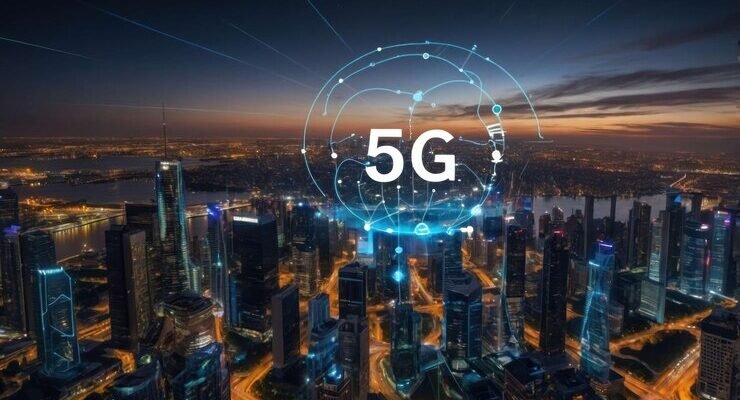
Tech enthusiasts! Buckle up, because we’re about to dive into the revolutionary world of 5G networks. If you haven’t heard the buzz about this cutting-edge technology, it’s time to get on board. 5G is more than just a fancy acronym – it’s a game-changer that will transform the way we live, work, and communicate.
Explore the top advantages of 5G networks, highlighting the benefits of faster speeds, lower latency, increased capacity, improved security, and enhanced IoT capabilities.
Key Takeaways:
- Get ready for lightning-fast download speeds that will make buffering a thing of the past.
- Bid farewell to frustrating lags and delays with the ultra-low latency of 5G networks.
- Brace yourself for a massive influx of connected devices, thanks to the increased capacity of 5G.
- Sleep soundly knowing your data is safer than ever with 5G’s robust security measures.
- Embrace the future of the Internet of Things (IoT) with 5G’s enhanced capabilities for connected devices.
Faster Speeds: Say Goodbye to Buffering Woes
One of the most talked-about advantages of 5G technology is its blistering fast data speeds. We’re not just talking about a minor upgrade here – we’re talking about speeds that will make your current internet connection look like a snail in a race against a cheetah.
Overview of the faster speeds offered by 5G networks
5G networks are designed to deliver peak data rates of up to 20 Gbps (yup, you read that right – gigabits per second!). That’s lightning-fast, folks. To put it in perspective, with 5G, you could download a full-length HD movie in a matter of seconds.
Benefits of faster speeds:
- Improved online gaming and streaming experiences: Say goodbye to frustrating lags and buffering interruptions. With 5G’s blazing-fast speeds, you can seamlessly stream your favorite shows, movies, and even live events without any hiccups.
- Enhanced video conferencing and virtual reality capabilities: Remote work just got a whole lot smoother. With 5G’s ultra-fast data transmission, you can enjoy crystal-clear video conferences and even dive into immersive virtual reality experiences without any lag or pixelation.
- Faster data transfer and download times: Need to share that massive project file with your colleagues? No problem! With 5G’s lightning-fast download speeds, you can transfer large files in the blink of an eye.
- Increased productivity and efficiency: Time is money, and with 5G’s speedy data transfer capabilities, you’ll be able to get more done in less time. Say goodbye to wasted hours waiting for files to upload or download.
Comparison of 5G speeds to previous network generations
Just to give you an idea of how mind-blowing 5G speeds are, let’s compare them to previous network generations. 4G LTE networks typically offer download speeds around 100 Mbps, which is already impressive. But 5G? We’re talking about download speeds up to 200 times faster than that! It’s like going from a tricycle to a Formula 1 racecar.
Lower Latency: Goodbye to Frustrating Lags and Delays
Imagine this: you’re in the middle of an intense online gaming session, and just as you’re about to deliver the final blow, your character freezes, and you miss your chance. Frustrating, right? Well, with 5G’s ultra-low latency, those annoying lags and delays will be a thing of the past.
Overview of the lower latency offered by 5G networks
Latency refers to the time it takes for data to travel from its source to its destination and back again. With 5G networks, we’re looking at latency as low as 1 millisecond – that’s faster than the blink of an eye!
Benefits of lower latency:
- Improved real-time communication and collaboration: Whether you’re participating in a video conference or collaborating on a shared document, 5G’s low latency ensures a seamless, real-time experience without any frustrating delays.
- Enhanced gaming and virtual reality experiences: Forget about lag and choppy gameplay. With 5G’s ultra-low latency, you can immerse yourself in realistic gaming and virtual reality experiences without any interruptions.
- Increased reliability and accuracy in mission-critical applications: From remote surgery to autonomous vehicles, 5G’s low latency ensures that critical data is transmitted with lightning-fast speed and pinpoint accuracy.
- Better support for emerging technologies: As new technologies like augmented reality, robotics, and smart cities continue to evolve, 5G’s low latency will be crucial in enabling real-time data communication and processing.
Comparison of 5G latency to previous network generations
Let’s put things into perspective again. While 4G LTE networks typically have a latency of around 50-100 milliseconds, 5G promises latency as low as 1 millisecond. That’s a massive improvement, and it opens up a world of possibilities for real-time applications that were simply not feasible before.
Increased Capacity: Connecting More Devices Than Ever Before
In today’s world, we’re surrounded by an ever-growing number of connected devices – from smartphones and tablets to smartwatches, home automation systems, and even smart appliances. With the increased capacity of 5G networks, we’re about to witness an explosion of connectivity like never before.
Overview of the increased capacity offered by 5G networks
5G networks are designed to support a massive number of connected devices within a given area. We’re talking about up to 1 million devices per square kilometer – that’s a mind-boggling number!
Benefits of increased capacity:
- Support for a larger number of connected devices: With 5G’s increased capacity, you can seamlessly connect all your smart devices without worrying about network congestion or performance issues.
- Improved network reliability and resilience: By distributing traffic across a larger number of devices, 5G networks can better handle spikes in data demand, ensuring a more reliable and consistent user experience.
- Enhanced support for IoT applications: The Internet of Things (IoT) is rapidly expanding, and with 5G’s increased capacity, we can expect to see more innovative IoT applications and services that leverage the power of interconnected devices.
- Increased efficiency and reduced costs for network operators: With 5G’s ability to support more devices per cell site, network operators can optimize their infrastructure and reduce operational costs, ultimately leading to better services and pricing for consumers.
Comparison of 5G capacity to previous network generations
To give you a sense of the massive leap in capacity, let’s compare 5G to its predecessor, 4G LTE. While 4G LTE networks can support up to 60,000 devices per square kilometer, 5G takes it to a whole new level with up to 1 million devices per square kilometer. That’s a staggering 16 times increase in capacity!
Improved Security: Keeping Your Data Safe and Sound
In today’s digital age, data security is paramount. With more and more of our personal and sensitive information being transmitted over wireless networks, it’s crucial to have robust security measures in place. Enter 5G networks, which offer a whole new level of security and privacy protection.
Overview of the improved security offered by 5G networks
5G networks are designed with advanced security protocols and encryption techniques to safeguard your data from potential threats and cyber-attacks.
Here are some key security features of 5G:
- Enhanced encryption and authentication protocols: 5G networks utilize stronger encryption algorithms and authentication mechanisms to ensure that only authorized devices and users can access the network.
- Improved network segmentation and isolation: 5G networks can be divided into logical segments or “slices,” allowing for better isolation and protection of sensitive data and applications.
- Increased support for secure communication protocols: 5G networks support a range of secure communication protocols, such as IPsec and TLS, to ensure end-to-end encryption and data integrity.
- Better protection against cyber threats and attacks: With built-in security features like user privacy, data integrity, and mobile device authentication, 5G networks are better equipped to defend against cyber threats like man-in-the-middle attacks, eavesdropping, and denial-of-service attacks.
Comparison of 5G security to previous network generations
While previous generations of cellular networks had security measures in place, 5G takes it to a whole new level. With its advanced security protocols and encryption techniques, 5G networks offer a significantly higher level of protection against cyber threats and data breaches.
For instance, 4G LTE networks primarily relied on traditional encryption methods like AES and SHA-256, which, while robust, are not immune to potential vulnerabilities. 5G, on the other hand, introduces new security algorithms and protocols specifically designed to address the evolving landscape of cyber threats.
One notable example is the inclusion of the SNOW-3G stream cipher, which provides enhanced encryption capabilities for both user data and signaling information. Additionally, 5G networks leverage the latest advancements in key management and authentication techniques, such as the Subscription Concealed Identifier (SUCI), which helps protect user privacy by obscuring the subscriber’s permanent identifier.
Furthermore, 5G networks incorporate improved network slicing capabilities, allowing for better isolation and protection of critical applications and services from potential breaches or attacks. This level of segmentation was not feasible in previous network generations, making 5G a game-changer in terms of secure and reliable connectivity for mission-critical applications.
Overall, the enhanced security features of 5G networks not only provide peace of mind for individual users but also pave the way for secure and reliable communication in industries such as finance, healthcare, and government, where data privacy and integrity are of utmost importance.
Enhanced IoT Capabilities: Unlocking a World of Connected Possibilities
The Internet of Things (IoT) has been a buzzword for quite some time, but with the advent of 5G networks, we’re about to witness a true revolution in the realm of connected devices. Get ready to step into a world where virtually everything around you can be connected and controlled with the touch of a button (or a voice command, for that matter).
Overview of the enhanced IoT capabilities offered by 5G networks
5G networks are designed to support a wide range of IoT applications and use cases, from low-power wide-area networks (LPWANs) to massive machine-type communications (mMTC). With its increased bandwidth, lower latency, and improved reliability, 5G networks can handle a massive influx of connected devices while ensuring seamless communication and data transmission.
Benefits of enhanced IoT capabilities:
- Improved support for low-power wide-area networks (LPWANs): 5G network Advantages can efficiently support low-power, battery-operated devices used in applications like smart metering, asset tracking, and environmental monitoring, enabling longer battery life and wider coverage.
- Enhanced support for massive machine-type communications (mMTC): With the ability to support millions of connected devices per square kilometer, 5G network Advantages can enable a truly connected world, where everything from smart home appliances to industrial machinery can communicate and exchange data seamlessly.
- Increased support for mission-critical IoT applications: The ultra-low latency and high reliability of 5G networks make them ideal for mission-critical IoT applications, such as remote healthcare, autonomous vehicles, and industrial automation, where real-time data transmission and decision-making are crucial.
- Improved support for emerging IoT technologies like edge computing: 5G network Advantages can facilitate the deployment of edge computing solutions, allowing for faster data processing and decision-making at the edge of the network, closer to the connected devices.
Comparison of 5G IoT capabilities to previous network generations
Previous cellular network generations, while enabling IoT connectivity to some extent, were not designed to handle the sheer volume and diversity of connected devices that we’re expecting with 5G. For example, 4G LTE networks were primarily optimized for mobile broadband and struggled to support low-power, battery-operated devices efficiently.
With 5G, we’re looking at a purpose-built network that can cater to a wide range of IoT use cases, from high-bandwidth applications like augmented reality and virtual reality, to low-power sensors and devices that require ultra-low latency and high reliability.
Conclusion
Phew, that was quite a journey, wasn’t it? We’ve explored the top advantages of 5G network Advantages, and it’s clear that this technology is poised to revolutionize the way we live, work, and interact with the world around us.
From lightning-fast download speeds that will make buffering a distant memory, to ultra-low latency that enables real-time communication and mission-critical applications, 5G networks are truly a game-changer.
But that’s not all – the increased capacity of 5G networks will usher in a new era of connectivity, where millions of devices can seamlessly communicate and exchange data, paving the way for groundbreaking IoT applications and smart city initiatives.













